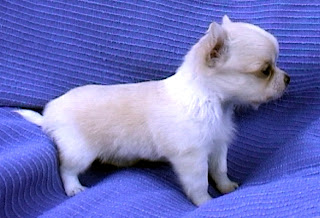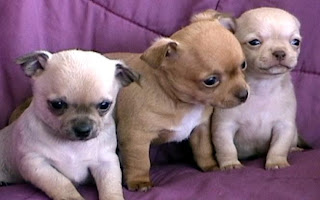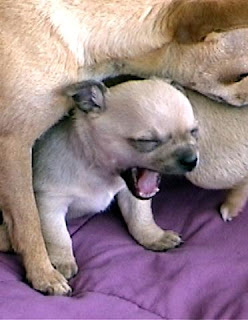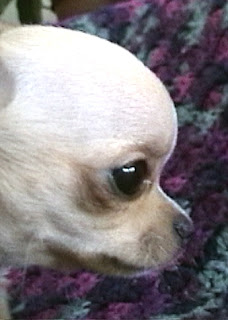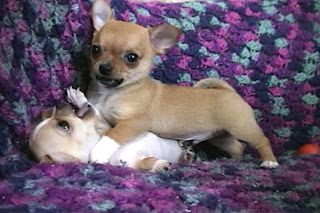
When you look at a Chihuahua that weighs less than two pounds
full grown, it is hard to imagine that it’s actually a dog!
That is why so many people once believed the rumor that
Chihuahuas were some kind of weird mix of rodent and canine.
The rumor began after people who traveled along the Mexican
Border with Texas and Arizona over one hundred and fifty years
ago noticed the breed.
Early Wild West novels and storybooks expanded on the rodent
mix rumor and explained the small size of the Chihuahua by
claiming that the animals were created through a secret process
used by native medicine men or pagan priests in Mexico or South
America. However, dime novels were not the only places where
tale tales about Chihuahuas were spread.
Early descriptions of the dogs by Missionaries and
Conquistadors traveling throughout South America indicated they
were used in worship ceremonies or even eaten by faithful
followers of the Aztec religion. Such descriptions were often
exaggerated to make the Aztec People seem completely pagan to
Christians and, thereby, justify their conquest and conversion.
While we are certain that Chihuahuas were used in Aztec worship
ceremonies, there is no evidence to date that any were eaten.
Many have been found buried with people, so it’s possible they
were killed to join their owners in death.
Because Chihuahuas are much smaller and seem to be so different
from other dog breeds, a number of old wives tales exist about
these tiny animals. Some are true, others are just myths spread
by the uninformed:
BAD BREATH - Chihuahuas have a breath odor that is no better or
worse than that of any other dog breed. This rumor started
because so many early Chihuahua owners fed their dogs unwanted
fish parts leading to a generally horrific mouth odor.
Captains, mates and others who worked aboard ships in the
California of the middle to late 1800’s found Chihuahua dogs to
be terrific companions. Not only would these dogs sound the
alarm if anyone came near their personal property, but they
were small enough to be welcome aboard vessels of any size.
Ship captains were particularly found of them because
Chihuahuas had a knack for chasing rats out of small spaces
that other dogs couldn’t reach. When pups came along and they
were sold to landlubbers, new owners were told that the dogs
just loved fish parts!
CHIHUAHUAS HAVE GIVEN BIRTH TO KITTENS - Chihuahuas tend to get
along unusually well with Cats. In fact, Chihuahuas have been
known to nurse orphaned or abandoned kittens. However, I can
say with great certainty that no Chihuahua has ever been known
to give birth to a litter of kittens.
CHIHUAHUAS COME FROM OUTTER SPACE - Some Natives of North and
South America have traditions that indicate their ancestors may
have come from the stars. Some researchers believe that’s an
incorrect interpretation of the native people’s belief that
their ancestors come from a higher spiritual existence. Either
way, early scholars who took an interest in the origin of
Chihuahuas indicated that they had not been able to discover
how, when or where the breed originated. As interest in ghosts,
Atlantis and space beings first became popular in the late
1800’s, many people adopted the idea that Chihuahuas must have
been brought to Earth by visitors from beyond. Needless to say,
this is probably not true and likely came from the same people
who believe that Corn is an Alien invention unfit for human
consumption.
CHIHUAHUAS CAN HEAL SEVERE INJURIES OR REDUCE PAIN - Early
settlers who came to the Southwest United States noticed that
Mexicans and some Native Americans would tie Chihuahuas to
parts of their bodies that seemed to need healing or where pain
was a problem. This practice lead to the theory that the dogs
were magical and could cure an assortment of physical problems.
In reality, Chihuahuas have been known to lie near or on parts
of their owner’s bodies where pain was being felt, an infection
had set in or other health problems may have existed. The warmth
of their tiny bodies probably helped ease pain a bit. The
licking of infections or open wounds may have helped clean out
microorganisms or infected tissues. Interestingly enough, it
has become known that some dogs seem to possess the ability to
diagnose cancer or other health problems in various parts of
the human body.
CHIHUAHUAS CAN CURE OR REDUCE THE SEVERITY OF ASTHMA AND
ALLERGIES - Most people with Asthma or severe Allergy problems
have a problem with furry pets. Not so, it seems, with the
Chihuahua. Although there is no known medical evidence to
support the idea that they can cure any disease, many Chihuahua
Owners who suffer with Asthma or severe Allergies claim the dogs
help. It has not been uncommon for people living in the
Southwest to get a Chihuahua for a child or family member with
Asthma or Allergy problems. The dogs sometimes lie near that
person’s mouth while they are sleeping and later become ill. At
the same time, the person involved would wake up feeling better.
The idea was that the problem was transferred from the suffering
human to the dog. Whether that part of the tale is true or not,
it is a fact that Asthma and Allergy sufferers seem to do
better with short or long haired Chihuahuas then with any other
dog breed.
CHIHUAHUAS COME FROM CHINA OR EGYPT - There is some evidence
that Chihuahuas may have already existed in Africa and Asia
before they were discovered in America, but none so conclusive
to say that they originated in any of those places. We are just
now discovering that seafarers may have visited our shores long
before Columbus or even the Vikings. This may account for the
presence of Chihuahuas in other parts of the world. No one
really knows the exact origin of the Chihuahua.
IF REALLY UPSET, A CHIHUAHUA’S EYES WILL FALL OUT OF IT’S HEAD
- The ‘bug eye’ look of some Chihuahuas undoubtedly lead to
this myth. Modern science has shown this to be false.
SEWER RATS HAVE BEEN SOLD AS CHIHUAHUAS - This is yet another
branch of the false rodent identity once attributed to
Chihuahua dogs. Years ago, a story appeared in one of the
supermarket tabloids proclaiming that a couple visiting Mexico
came upon the hybrid of a rat-dog mix that looked like a
Chihuahua. The story went on to say that purchased the creature
and brought their discovery back to the USA. Once home, the
animal attacked and killed cats and even large dogs in their
neighborhood leading to the need for its destruction. This lead
to the often repeated and equally nonsensical rumor of a couple
who vacationed in Mexico and brought home a sewer rat they had
purchased as a Chihuahua.
AN ANCIENT CHIHUAHUA WAS DISCOVERED PERFECTLY PRESERVED IN A
SOUTH AMERICAN PYRAMID - Here is another crazy story courtesy
of our friends at the supermarket tabloids. This one appeared
in an early 1970’s tabloid article. A perfectly preserved
Chihuahua was said to have been discovered in a South American
pyramid amongst a king's ransom in gold and jewels. The article
claimed that the animal was so perfectly preserved that the
dog’s flesh was still edible, blood samples could be extracted
from the dog’s body and the animal’s eyes were a color never
before seen in animals(???). Well, they made it up, not me!
The craziest thing about all the tale tales that surround the
Chihuahua Breed is that some may actually be true. The
Chihuahua is the world’s smallest dog breed and longest-lived.
Animal Behaviorists tell us that Chihuahuas are the only dogs
that tend to prefer the company of humans to that of other
dogs. They will nurse kittens and seem to have helped people
who suffer from various maladies. With a background like that,
I suppose almost anything is possible. However, one thing is
for sure. They make the world’s best pets! You can read more
about Chihuahuas at
http://www.ArizonaPups.com and find free
dog training and health tips at
http://doggiestyle.billknell.com
About the Author: Bill Knell. Email:
billknell@cox.net.
Website:
http://www.billknell.com Terms To Use Article:
Permission is granted to use this article for free online or in
print. Please add a link to or print my website address:
http://www.billknell.comSource:
http://www.isnare.com
